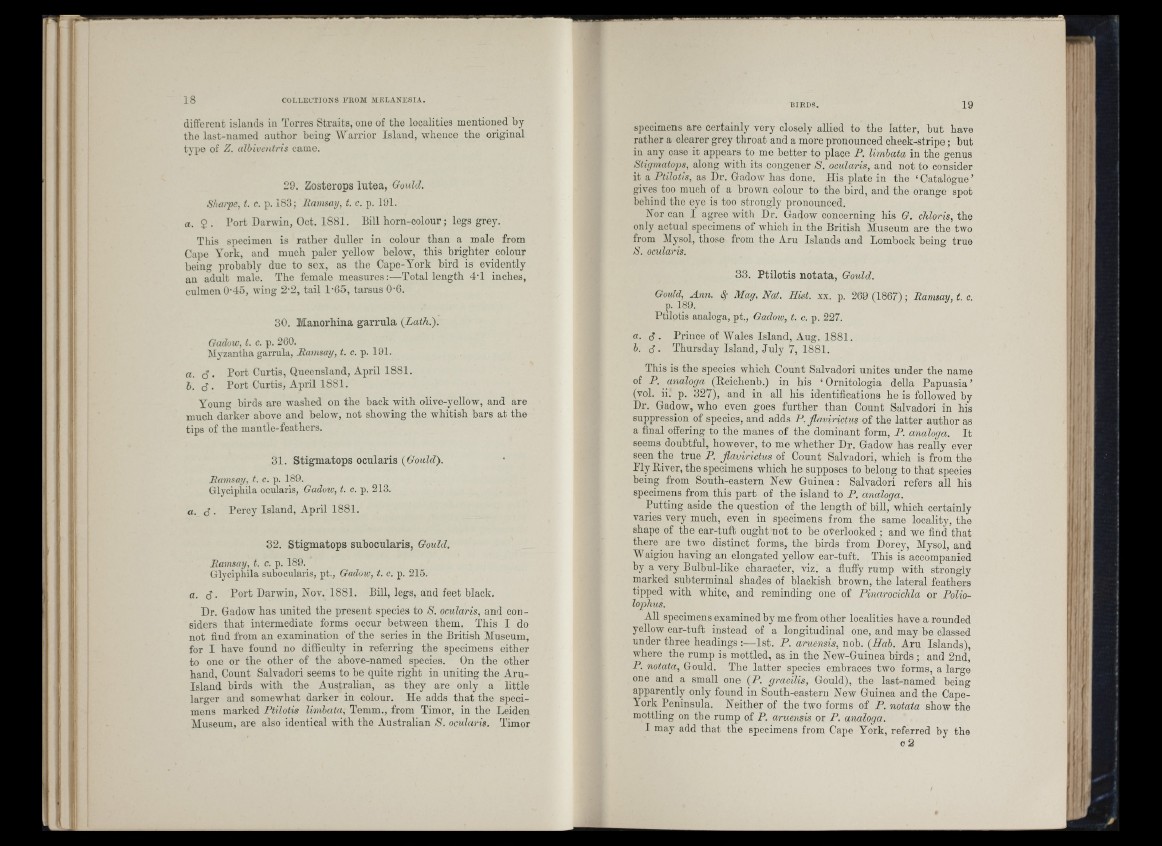
BIRDS. 19
different islands iii Torres Straits, one of the localities mentioned by
the last-named author being Warrior Island, whence the original
type of Z. albiventris came.
29. Zosterops lutea, Gould.
Sharpe, t. c. p. 183; Itamsay, t. c. p. 191.
a. ? . Port Darwin, Oct. 1881. Bill horn-colour; legs grey.
This specimen is rather duller in colour than a male from
Cape York, and much paler yellow below, this brighter colour
being probably due to sex, as the Cape-York bird is evidently
an adult male. The female measures:—-Total length 4-1 inches,
culmen 0-45, wing 2-2, tail 1-65, tarsus 0’6.
30. Manorhina garrula {Lath.).
Gadow, t. c. p. 260.
Myzantha garrula, Ramsay, t. c. p. 191.
a. S ■ Po'ft Curtis, Queensland, April 1881.
h. d . Port Curtis, Apiril 1881.
Young birds are washed on the back with olive-yellow, and are
much darker above and below, not showing the whitish bars at the
tips of the mantle-feathers.
31. Stigmatops ocularis {Gould).
Ramsay, t. c. p. 189.
Glycipiiila ocularis, Gadoiv, t. c. p. 213.
a. d . Percy Island, April 1881.
32. Stigmatops suhocularis, Gould.
Ramsay, t. c. p. 189.
Glycipiiila subocularis, pt., Gadow, t. c. p. 215.
a. d ■ Darwin, Nov. 1881. Bill, legs, and feet black.
Dr. Gadow has united the present species to S. ocularis, and considers
th at intermediate forms occur between them. This I do
not find from an examination of the series in the British Museum,
for I have found no difficulty in referring the specimens either
to one or the other of the above-named species. On the other
hand, Count Salvador! seems to he quite right in uniting the Aru-
Island birds with the Austrahan, as they are only a little
larger and somewhat darker in colour. He adds th at the specimens
marked Ptilotis limbata, Temm., from Timor, in the Leiden
Museum, are also identical with the Australian S, ocularis, Timor
sjiecimens are certainly very closely allied to the latter, but have
rather a clearer grey throat aud a more pronounced cheek-stripe ; but
in any case it appears to me better to place P. limbata in the genus
Stigmatops, along with its congener S. ocularis, and not to consider
it a Ptilotis, as Dr. Gadow has done. His plate in the ‘Catalogue’
gives too much of a brown colour to the bird, and the orange spot
behind the eye is too strongly pronounced.
Nor can I agree with Dr. Gadow concerning his G. chloris, the
only actual specimens of which in the British Museum are the two
from Mysol, those from the Aru Islands and Lombock being true
S. ondaris.
33. Ptilotis notata, Gould.
Gould,^Ann. ^ Mag. Nat. Hist. xx. p. 269 (1867) ; Ramsay, t. c.
Ptilotis analoga, pt., Gadow, t. c. p. 227.
a. d . Prince of Wales Island, Aug. 1881.
h. d ■ Thursday Island, July 7, 1881.
This is the species which Count Salvador! unites under the name
of P. analoga (Eeichenb.) in his ‘ Ornitologia della P ap u asia’
(vol. ii. p. 327), and in all his identifications he is followed by
Dr. Gadow, who even goes further than Count Salvador! in his
suppression of species, and adds P. jiavirictus of the latter author as
a final offering to the manes of the dominant form, P. analoga. I t
seems doubtful, however, to me whether Dr. Gadow has really ever
seen the true P. jiavirictus of Count Salvadori, which is from the
Fly Eiver, the specimens which he supposes to belong to th at species
being from South-eastern New Guinea: Salvadori refers all his
specimens from this part of the island to P. analoga.
Putting aside the question of the length of bill, which certainly
varies very much, even in specimens from the same locality, the
shape of the ear-tuft ought not to be overlooked ; and we find that
there are two distinct forms, the birds from Dorey, Mysol, and
Waigiou having an elongated yellow ear-tuft. This is accompanied
by a very Bulbul-like character, viz. a fluffy rump with strongly
rnarked subterminal shades of lilackish brown, the lateral feathers
tipped with white, and reminding one of Pinarocichla or Polio-
lophus.
All specimens examined by me from other localities have a rounded
yellow ear-tuft instead of a longitudinal one, and may he classed
under three headings :—1st. P. aruensis, nob. {Hah. Aru Islands),
where the rump is mottled, as in tho New-Guinea birds ; and 2nd,
P. notata, Gould. The latter species embraces two forms, a large
one and a small one (P. gracilis, Gould), the last-named being
apparently only found in South-eastern New Guinea and the Cape-
York Peninsula. Neither of the two forms of P. notata show the
mottling on the rump of P. aruensis or P. analoga.
I may add that the specimens from Cape York, referred by the
o 2